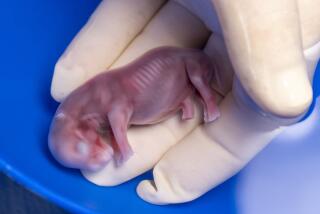Growing Demand for Lean Meat Spurs Embryo-Transfer Experiments With Bison
- Share via
CHEYENNE, Wyo. — Modern pioneers of bison breeding are trying to raise large numbers of the burly beasts as a source of low-cholesterol meat.
Using cows as surrogate mothers, a Cheyenne-based group of scientists and ranchers plans to supply an increasingly health-conscious American market.
“We see there is nowhere near the number of bison for the demand,” said Paul Butler, manager of the group, Livestock Research and Innovation. “In order to make any type of dramatic increase you’ve got to use the new techniques.”
The bison was nearly extinct by the end of the last century, after hide-hunters had reduced a herd that once numbered in the millions to fewer than 300. Now there are between 80,000 and 100,000 bison, according to the Denver-based American Buffalo Assn.
“Basically, the meat’s better,” Butler said, referring to positive results from taste tests. “It’s got more protein and less fat, and yet it’s tender and flavorful.”
The company hopes to capitalize on the demand for leaner meats by implanting bison embryos in cows and milk-feeding the calves until they reach the age of slaughter. With help from the University of Wyoming, researchers have been inseminating female bisons treated with hormones. The fertilized embryos are flushed out of the bisons and implanted in the cows, so that the bison can produce more embryos instead of going through pregnancy.
So far, all the implanted bison embryos have been rejected, but the confidence of embryo-transfer experts and interest expressed by the Wyoming Department of Agriculture have kept the project going.
“We’ve got to perfect the techniques,” Butler said. “There are certain adjustments we have to make when working with bisons. They are a big, strong, wild animal. They’re not easy to handle.”
Colorado State University professor George Seidel, a reproductive physiologist and pioneer in embryo transfers with other livestock, does not doubt that the methods will work with bison.
“The technique is not too different from the test-tube baby,” Seidel said. “I would expect it would work.”
Meanwhile, Butler has been talking with buyers in New Zealand and Australia. Besides bison meat, he envisions selling frozen bison embryos for about $10,000 each.
And a University of Wyoming marketing report suggested multiple uses for bison.
“With bison, you can sell everything from the head to the tail,” the report said. “Bison by-products include heads, robes, skulls, leather goods, wood and jewelry made from their bones and horns.”
Ranchers are quick to point out the profit potential of an enterprise that could dramatically increase the bison population.
“There’s an incredible market for it,” said John Flocchini, who manages a herd of about 2,500 buffalo on the Durham Ranch near Gillette. “I wish we had about five or six times the number of animals that we have.”
The Durham ranch sells bison meat in California, where Flocchini has found “way more demand than supply.”
Moreover, Flocchini and others believe few animals are more suitable than bison for Wyoming, where harsh winters and predators pose problems for cattle.
A recent study of the Canadian Wildlife Service found that bison use nutrients in poor feed grain more efficiently than cattle. The study concluded that “bison ranching could be an alternative to cattle in areas of poor forage and severe winters.”
Not everyone is so enthusiastic, however.
Jeremy Rifkin, president of the Foundation on Economic Trends, has warned that mixing breeds can lead to an undesirable homogenization of species.
More to Read
Sign up for Essential California
The most important California stories and recommendations in your inbox every morning.
You may occasionally receive promotional content from the Los Angeles Times.













